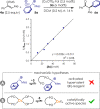Enantioselective α-Arylation of Ketones via a Novel Cu(I)-Bis(phosphine) Dioxide Catalytic System
- PMID: 33635068
- PMCID: PMC8041290
- DOI: 10.1021/jacs.0c13236
Enantioselective α-Arylation of Ketones via a Novel Cu(I)-Bis(phosphine) Dioxide Catalytic System
Abstract
A novel catalytic system based on copper(I) and chiral bis(phosphine) dioxides is described. This allows the arylation of silyl enol ethers to access enolizable α-arylated ketones in good yields and enantiomeric excess up to 95%. Noncyclic ketones are amenable substrates with this method, which complements other approaches based on palladium catalysis. Optimization of the ligand structure is accomplished via rational design driven by correlation analysis. Preliminary mechanistic hypotheses are also evaluated in order to identify the role of chiral bis(phosphine) dioxides.
Conflict of interest statement
The authors declare no competing financial interest.
Figures




Similar articles
-
One-pot sequential Cu-catalyzed reduction and Pd-catalyzed arylation of silyl enol ethers.Org Lett. 2004 Dec 23;6(26):4809-12. doi: 10.1021/ol048313c. Org Lett. 2004. PMID: 15606072
-
Electrochemical α-Arylation of Ketones via Anodic Oxidation of In Situ Generated Silyl Enol Ethers.J Org Chem. 2021 Nov 19;86(22):16026-16034. doi: 10.1021/acs.joc.1c01224. Epub 2021 Aug 3. J Org Chem. 2021. PMID: 34343004
-
A novel alpha-arylation of ketones, aldehydes, and esters via a photoinduced SN1 reaction through 4-aminophenyl cations.J Org Chem. 2003 Jun 13;68(12):4886-93. doi: 10.1021/jo034375p. J Org Chem. 2003. PMID: 12790595
-
Asymmetric Catalysis with Ethylene. Synthesis of Functionalized Chiral Enolates.J Am Chem Soc. 2015 Nov 18;137(45):14268-71. doi: 10.1021/jacs.5b10364. Epub 2015 Nov 10. J Am Chem Soc. 2015. PMID: 26529467 Free PMC article.
-
Enantioselective aldol reactions catalyzed by chiral phosphine oxides.Chem Rec. 2013 Aug;13(4):362-70. doi: 10.1002/tcr.201300004. Epub 2013 Jul 4. Chem Rec. 2013. PMID: 23828817 Review.
Cited by
-
Catalytic asymmetric defluorinative allylation of silyl enol ethers.Chem Sci. 2023 May 24;14(26):7147-7153. doi: 10.1039/d3sc01498c. eCollection 2023 Jul 5. Chem Sci. 2023. PMID: 37416711 Free PMC article.
-
Ligand-Metal Cooperation Enables Net Ring-Opening C-C Activation / Difunctionalization of Cyclopropyl Ketones.ACS Catal. 2023 Sep 1;13(17):11277-11290. doi: 10.1021/acscatal.3c02643. Epub 2023 Aug 11. ACS Catal. 2023. PMID: 39386022 Free PMC article.
-
Insights into Single-Electron-Transfer Processes in Frustrated Lewis Pair Chemistry and Related Donor-Acceptor Systems in Main Group Chemistry.Chem Rev. 2023 Aug 9;123(15):9653-9675. doi: 10.1021/acs.chemrev.3c00217. Epub 2023 Jul 11. Chem Rev. 2023. PMID: 37431868 Free PMC article. Review.
-
Rapid assembly of enantioenriched α-arylated ketones via Ni-catalyzed asymmetric cross-hydrocarbonylation enabled by alkene sorting.Nat Commun. 2025 May 5;16(1):4163. doi: 10.1038/s41467-025-57967-4. Nat Commun. 2025. PMID: 40325002 Free PMC article.
-
Enantioselective synthesis of α,α-diarylketones by sequential visible light photoactivation and phosphoric acid catalysis.Sci Adv. 2023 Jun 16;9(24):eadg7754. doi: 10.1126/sciadv.adg7754. Epub 2023 Jun 16. Sci Adv. 2023. PMID: 37327329 Free PMC article.
References
-
- Palucki M.; Buchwald S. L. Palladium-Catalyzed α-Arylation of Ketones. J. Am. Chem. Soc. 1997, 119, 11108.10.1021/ja972593s. - DOI
-
- Hamann B. C.; Hartwig J. F. Palladium-Catalyzed Direct α-Arylation of Ketones. Rate Acceleration by Sterically Hindered Chelating Ligands and Reductive Elimination from a Transition Metal Enolate Complex. J. Am. Chem. Soc. 1997, 119, 12382.10.1021/ja9727880. - DOI
-
- Hao Y.-J.; Hu X.-S.; Zhou Y.; Zhou J.; Yu J.-S. Catalytic Enantioselective α-Arylation of Carbonyl Enolates and Related Compounds. ACS Catal. 2020, 10, 955.10.1021/acscatal.9b04480. - DOI
Publication types
LinkOut - more resources
Full Text Sources
Other Literature Sources
Miscellaneous

